The basic definition Vertical motion and examples
This article will be about the vertical motion, with the formulas we have to use to solve problems, and examples.
What is the vertical motion
The vertical motion is a motion that happens when we throw an object totally up, this means that the initial velocity or the force is only applied in the vertical axis, this is why this motion only has vertical movement and in case there is a horizontal motion, it is because of the air that makes the object move.
The vertical motion could be seen as a uniformly accelerated motion variant, that moves in the “y” axis, because normally a uniformly accelerated motion moves in the “x” axis. The vertical motion could be seen as a uniformly accelerated motion but with the difference that the acceleration in this motion will be equals to the gravity. The gravity is an acceleration that points down, this means that the sign of the gravity will be negative.
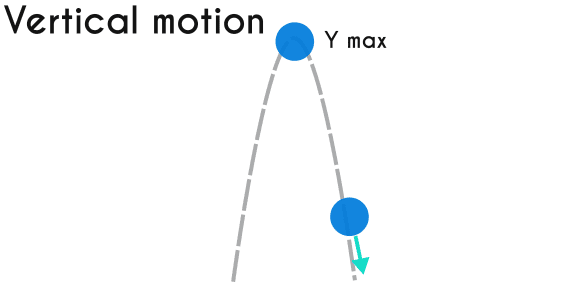
Vertical motion characteristics
One of the main conditions of the vertical motion is that its initial velocity has to be different than 0, if the initial velocity is positive, then the object will start to raise, slowing down the velocity until the velocity is equals to 0, and after that moment the object will start falling down, and the velocity will increase constantly in the opposite direction until the object impacts with the floor.
In case the initial velocity of the object is negative, the object will star descending to the floor and its velocity will be higher every second until it impacts with the floor.
A projectile motion can become a vertical motion if the inclination angle of the initial velocity is equals to 90°, because when the inclination is 90°, the whole force of the initial velocity will be applied in the vertical axis, so there will only be a vertical movement.
Vertical motion formulas
The vertical motion formulas are the same formulas we use in uniformly accelerated motion, but, as we said before, with the difference that the acceleration will be equals to the value of the gravity, but with the negative sign.
The following formulas are the vertical motion formulas, this are already with the changes we explained before and also simplified with the vertical motion parameters.
- y max = vo2 / 2g
- t max = 2(vo) / g
- The previous last formula only works if the object lands on the same floor it started
- And the uniformly accelerated motion formulas
- vf = vo - g . t
- y = vo . t - 1/2g.t2
- vf 2= vo 2 - 2g . y
- y = ( (vo + vf) /2).t
Vertical motion Examples
Example 1: An archer shoots an arrow up from the floor at a velocity of 4m/s ¿Define the height that the arrow reached?
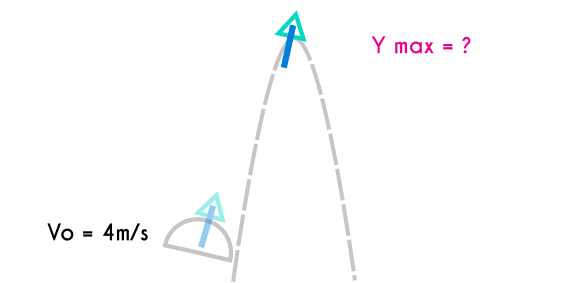
Vo = 4 m/s Ymax = ?
- We write the equation
- y max = vo2 / 2g
- replace the data and solve
- y max = 4 m/s 2 / 2(9.8)
- y max = 16 m/s / 19.6 m/s 2
- y max = 0.82
Example 2: A person throws a rock up at a velocity of 3.2m/s Calculate the time that it took to the rock to hit the floor.
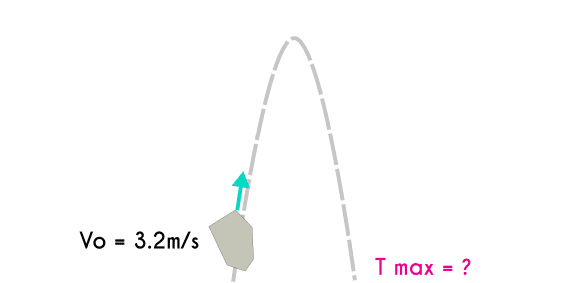
Vo = 3.2 m/s T = ?
- We write the formula and solve
- t max = 2(vo) / g
- t max = 2(3.2) / g
- t max = 6.4 / 9.8
- t max = 0.65
Example 3: A rocket made of cola drinks and mints reached a height of 15 meters, knowing this calculate the initial velocity of the rocket.
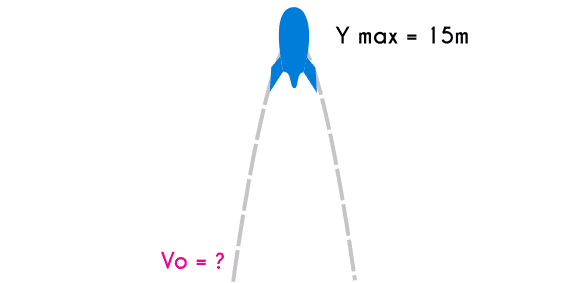
Ymax = 15m Vo = ?
Reminder: when we throw an object up, when it reaches its maximum height the velocity is equals to 0 at that moment is.
- We write the formula
- vf2 = vo2 - 2 * g * y
- and clear vo
- vo2 = vf2 + 2 * g * y
- Then we solve
- vo2 = 02 + 2 * 9.8 * 15
- vo2 = 2 * 9.8 * 15
- vo2 = 294
- vo = √ 294
- Vo = 17.15 m/s
Example 4: A person whant to throw a ball with enough velocity so the ball reaches a 25 meters height, calculate the velocity this person has to apply to the ball so the ball reaches that height
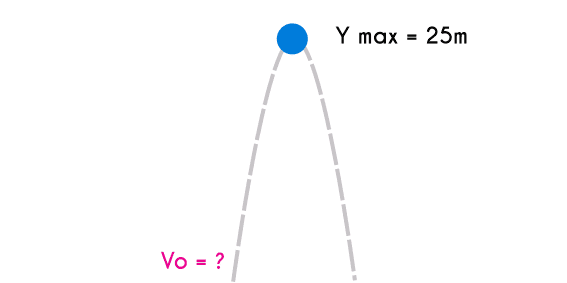
Ymax = 25m Vo = ?
- We write the equation
- vf2 = vo2 - 2 * g * y
- Then we clear vo
- vo2 = vf2 + 2 * g * y
- We replace the data
- vo2 = 02 + 2 * 9.8 * 25
- And we solve the operations
- vo2 = 2 * 9.8 * 25
- vo2 = 490
- vo = √ 490
- Vo = 22.1 m/s